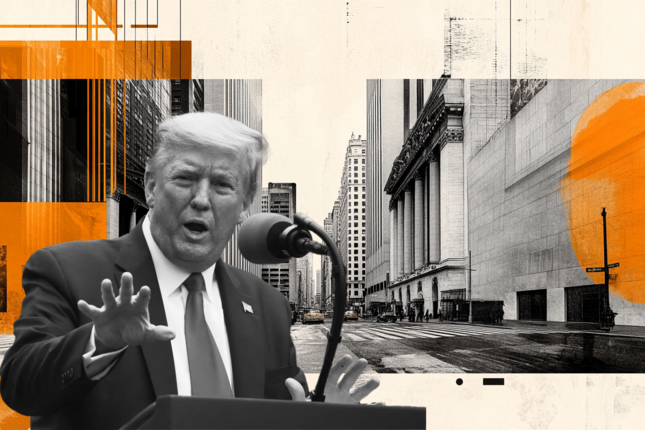Market wrap
Chinese equities plunged, sparking a regional selloff as Asia did not fully benefit from Wall Street’s risk-on bounce, which was fueled by hints of a more controlled U.S. tariff rollout in April. However, the local market reassessment hit hard and swiftly for those stocks in the White House’s “Dirty 15” crosshairs—China and its “China Plus One” supply chain partners.
Hong Kong’s Hang Seng Tech gauge plunged as much as 3.8%, marking its worst intraday drop in three weeks, with Alibaba Group and Xiaomi Corp. among the heaviest drags. The session saw a broad de-risking sweep through tech and consumer cyclicals as traders moved to de-lever and reduce beta exposure ahead of April’s geopolitical risk event.
It’s a textbook rotation out of tariff-sensitive names, especially with the market now betting that China and its Plus One crew will feel an intense salvo of U.S. tariff firepower.
Meanwhile, U.S. equity-index futures softened, hinting the overnight rally in New York might not have much follow-through later in the day. Traders are now reassessing whether the tariff reprieve narrative was a one-day wonder or something with real staying power.
To be sure, while this latest White House tariff stance is rumoured to be narrower and more calibrated than Trump’s earlier hardline rhetoric, let’s not pretend we’ve seen the full playbook. The scope, scale, and sequencing of the tariff package remain highly speculative. With no concrete details confirmed, markets are still navigating in the dark, and any extension of the US relief rally will ultimately depend on how aggressive the fine print turns out to be—the devil is very much in the details.
But let’s be honest—true reciprocity is a regulatory minefield. Products can be subdivided endlessly, and what looks symmetrical on paper often falls apart in practice. Achieving reciprocity at the product or sector level demands excruciating granularity—not just in terms of product classification codes but also in how those goods are treated under each country’s domestic tax, subsidy, and regulatory frameworks.
And even if you manage to navigate that labyrinth, all bets are off once the political lobbying machine kicks in. Companies and foreign governments are bound to present their case directly to the White House by making foreign direct investments stateside or lowering their trade barriers. The president, meanwhile, has the authority to override, adjust, or amplify tariff actions at a moment’s notice. The bottom line is that reciprocal tariffs appear straightforward—but in practice, they’re anything but.
That said, it’s difficult not to assume that the political tariff calculus will be ruthlessly calibrated to maximize external harm while minimizing internal backlash.
Forex markets
Tariff headlines may be dominating the news cycle, but are they offering more smoke than signal?
Still, U.S. markets chose to see the glass half full—risk sentiment firmed, and Treasury yields pushed higher, with investors leaning into the idea that a more calibrated tariff rollout won’t be as economically damaging stateside.
Europe, on the other hand, was a different story. Risk assets lagged, and whatever lift had been priced into long-end yields from fiscal reform hopes is now fading as markets come to grips with the fact that the economic impact is too far down the road to matter now. Meanwhile, the ECB’s dovish tones helped steepen the curve and not in a Euro-supportive way.
The result? More euro softness, as diverging rate paths and risk appetite flows continue to favor the dollar—even if nobody’s really sure what the next tariff headline will bring.
Treasuries saw meaningful moves Monday, with yields grinding higher across the curve as markets kicked off the week in a decidedly risk-on fashion. While early survey data pointed to resilience in the services sector, the bigger impulse came from a temporary calm ahead of what the Trump administration mischievously brands “Liberation Day” on April 2—the next big chapter in the tariff saga.
Volatility continued its downward drift, giving investors a green light to add exposure while headlines remain in wait-and-see mode. Some attributed the rally in risk to speculation that reciprocal tariff plans may be watered down, but we’re not convinced that’s the main engine driving price action. Markets still don’t know what’s coming, and that uncertainty keeps the geopolitical premium firmly in place.
What did have teeth, however, was Friday’s PCE report. It came in with a decent whiff of sticky inflation, reinforcing the narrative that the Fed is in no hurry to pivot. Core inflation metrics stayed hot enough to cement the case for a prolonged pause, keeping the dollar supported and pushing rate cut bets further out on the curve.
Our base case—EUR/USD peaking at 1.0950 before rolling over as the fiscal sugar high fades and tariff D-Day looms large—is unfolding almost to script. That said, I had expected us to be trading comfortably below 1.0750 by now, but price action suggests some traders ( including myself ) think there's quiet diplomatic horse-trading happening behind the scenes, even if Brussels and Washington are still throwing shade in public.
Likewise, our long U.S. dollar basket versus Asia (CNH, THB, SGD) is firmly in the green and quietly collecting carry, but let’s be honest—the fireworks haven’t gone off just yet. The worst-case tariff scenario still isn’t fully priced in, which means while we’re comfortably onside, we haven’t seen the kind of explosive FX repricing that could come if the White House goes full hawk on trade.
For now, it’s more of a grind higher with carry as the bonus, but the setup is there for an asymmetric move if the April 2 narrative shifts from “measured” to “mayhem.” Stay long, stay patient—the fuse is lit, even if the bang hasn’t happened... yet.
Still, with that in mind, we're not eager to chase the euro lower just yet. The prudent move here is to lock in some profits while keeping some shorts intact and waiting for the next set-up. The wildcard? Saudi Arabia, of all places. A U.S. delegation just met with Russian counterparts following prior talks with Ukraine, and there’s chatter that a joint statement could drop today. Any hint of a ceasefire breakthrough would light a fire under European sentiment—and by extension, the euro.
On the flip side, if the ceasefire noise fades and it’s more geopolitical theater than real progress, expect the euro—already looking technically heavy and near-term overbought—to slide back into soft territory.
EUR/USD has dipped back below 1.0800, and with U.S. consumer confidence data on deck, we can’t rule out a quick pop higher. But my bias is unchanged: looking to fade any rally toward1.0875- 1.0900, with a target south of 1.0700 in April as the tariff hammer drops and the macro divergence reasserts itself.
SPI Asset Management provides forex, commodities, and global indices analysis, in a timely and accurate fashion on major economic trends, technical analysis, and worldwide events that impact different asset classes and investors.
Our publications are for general information purposes only. It is not investment advice or a solicitation to buy or sell securities.
Opinions are the authors — not necessarily SPI Asset Management its officers or directors. Leveraged trading is high risk and not suitable for all. Losses can exceed investments.
Recommended Content
Editors’ Picks

AUD/USD consolidates around 0.6400; remains close to YTD top
AUD/USD holds steady around the 0.6400 mark on Friday and remains well within striking distance of the YTD peak touched earlier this week. A positive risk tone, along with the potential for a de-escalation in the US-China trade war, act as a tailwind for the Aussie amid a bank holiday in Australia and the lack of any meaningful USD buying.

USD/JPY edges higher to 143.00 mark despite strong Tokyo CPI print
USD/JPY attracts some dip-buyers following Thursday's pullback from a two-week high as hopes for an eventual US-China trade deal tempers demand for the JPY. Data released this Friday showed that core inflation in Tokyo accelerated sharply in April, bolstering bets for more rate hikes by the BoJ.

Gold price climbs past $3,300 on uncertainty about trade and weak USD
Gold snaps two-day losing streak, gaining 1.5% on fresh trade war fears. Trump softens tariff talk, but China denies negotiations and demands full rollback. Fed rate cut bets rise as yields drop and economic uncertainty builds.

TON Foundation appoints new CEO after $400M investment: Will Toncoin price reach $5 in 2025?
TON Foundation has appointed Maximilian Crown, co-founder of MoonPay, as its new CEO. Toncoin price remained muted, consolidating with a tight 2% range between $3.08 and $3.21 on Thursday.

Five fundamentals for the week: Traders confront the trade war, important surveys, key Fed speech Premium
Will the US strike a trade deal with Japan? That would be positive progress. However, recent developments are not that positive, and there's only one certainty: headlines will dominate markets. Fresh US economic data is also of interest.

The Best brokers to trade EUR/USD
SPONSORED Discover the top brokers for trading EUR/USD in 2025. Our list features brokers with competitive spreads, fast execution, and powerful platforms. Whether you're a beginner or an expert, find the right partner to navigate the dynamic Forex market.